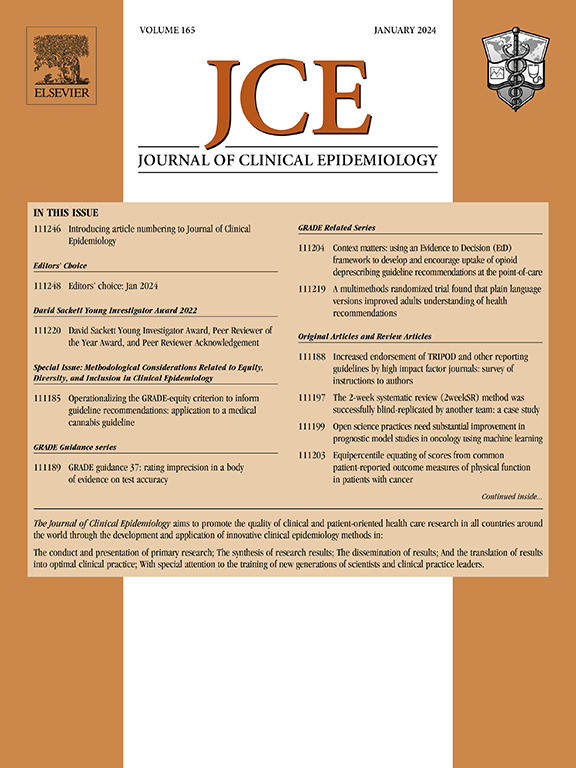Patterns of preregistration and publication of trials in Cochrane systematic reviews of interventions
IF 5.2
2区 医学
Q1 HEALTH CARE SCIENCES & SERVICES
引用次数: 0
Abstract
Objectives
It is widely recognized that selective reporting clinical trial results based on their outcomes, in the forms of publication bias, outcome reporting bias, or p-hacking, has detrimental effects on the scientific literature and on evidence synthesis. This can be recognized and perhaps ameliorated with comprehensive trial registration. However, previous investigations of clinical trial registration focused on study-level examinations rather than the number of trial participants, which is often more relevant to meta-analysis. Our objective was to investigate the risk of bias from selective reporting considering both trials but also the number of included participants.
Methods
We took a random sample of 50 Cochrane systematic reviews (SRs) of interventions which included randomized controlled trials, forming a retrospective cohort. Focusing on the primary outcome in the SR we used the review, published trial information, and public trial registration documents to collect information about the reviews themselves, as well as information about “included,” “ongoing,” and studies “awaiting classification”.
Results
In all 50 selected reviews, there were 423 “included” trials which examined the primary outcome, of which 109 (25.7%) were preregistered. There was substantial variability in proportions of preregistration of included trials among reviews, with a median of 16.0% (interquartile range 0%−79.6%). Registered trials covered 60.1% of all participants, suggesting larger studies were more likely to be preregistered. The proportion of participants in registered trials which were published was high (98.2%), but the proportion of registered trials which were published also varied substantially between reviews.
Conclusion
We found that in Cochrane reviews, there remains a low rate of preregistration among included studies and evidence for a substantial rate of trial nonreporting of registered trials. However, preregistered trials contributed proportionally more patients to reviews, and findings remain unpublished for only a small proportion of participants in registered trials.
Plain Language Summary
Trials are an important form of evidence in scientific literature that are often combined into systematic reviews (SRs), which give an overview for the evidence in a specific topic. However, trials and therefore the reviews can be misleading when the authors change the outcomes that they report based on the results they find, which is called reporting bias. One way of minimizing reporting bias is to register the planned methods for the trial in advance, known as preregistration. It is known that the proportion of trials that is registered can be low, but when conducting SRs the results are affected more by the number of participants within trials than the number of trials, which has not been previously studied. We aimed to make an up-to-date estimate of the proportion of preregistered trials in Cochrane SRs but also find out the proportion of participants within registered trials in these reviews. To do this we took a random sample of 50 Cochrane SRs, which conduct careful searches for registered trials whether or not they are published, and examined the trials within these reviews that studied the outcome the review declared to be most important. We found that even in modern SRs, only 25% of trials were preregistered, and that this number was very variable in reviews of different clinical questions. However we found that 60% of the patients in the reviews were within the preregistered trials, indicating that preregistered trials are generally larger than unregistered trials. We also found that more than 90% of preregistered studies were published. However, a major problem with this approach is that we cannot detect trials that were started without registration and then never published, which means that our results may underestimate the problem. Overall, this indicates that the risk of reporting bias is somewhat lower when considering participants rather than trials, but the risk of reporting bias is still high even in modern, rigorous reviews in medical science.
Cochrane干预措施系统综述中试验的预注册和发表模式。
目的:人们普遍认为,以发表偏倚、结果报告偏倚或p-hacking等形式选择性地根据临床试验结果报告临床试验结果,对科学文献和证据合成有不利影响。这一点可以通过全面的试验登记得到承认,或许还可以得到改善。然而,先前的临床试验注册调查侧重于研究水平的检查,而不是试验参与者的数量,这通常与荟萃分析更相关。我们的目的是调查选择性报道的偏倚风险,考虑到两个试验以及纳入的参与者数量。方法:我们随机抽取50个Cochrane系统评价的干预措施,包括随机对照试验,形成回顾性队列。针对系统评价的主要结局,我们使用综述、已发表的试验信息和公开试验注册文件来收集有关综述本身的信息,以及“纳入”、“正在进行”和“等待分类”的研究的信息。结果:在所有50篇综述中,有423项“纳入”试验检查了主要结局,其中109项(25.7%)是预先注册的。综述中纳入试验的预注册比例存在很大差异,中位数为16.0% (IQR 0-79.6%)。注册试验覆盖了所有参与者的60.1%,这表明更大的研究更有可能是预先注册的。已发表的注册试验的参与者比例很高(98.2%),但在不同的综述中,已发表的注册试验的比例也有很大差异。结论:我们发现在Cochrane综述中,在纳入的研究中,预注册率仍然很低,并且有证据表明有相当比例的试验未报告注册试验。然而,预先注册的试验为综述贡献了更多的患者,并且只有一小部分注册试验参与者的研究结果未发表。
本文章由计算机程序翻译,如有差异,请以英文原文为准。
求助全文
约1分钟内获得全文
求助全文
来源期刊

Journal of Clinical Epidemiology
医学-公共卫生、环境卫生与职业卫生
CiteScore
12.00
自引率
6.90%
发文量
320
审稿时长
44 days
期刊介绍:
The Journal of Clinical Epidemiology strives to enhance the quality of clinical and patient-oriented healthcare research by advancing and applying innovative methods in conducting, presenting, synthesizing, disseminating, and translating research results into optimal clinical practice. Special emphasis is placed on training new generations of scientists and clinical practice leaders.
 求助内容:
求助内容: 应助结果提醒方式:
应助结果提醒方式:


